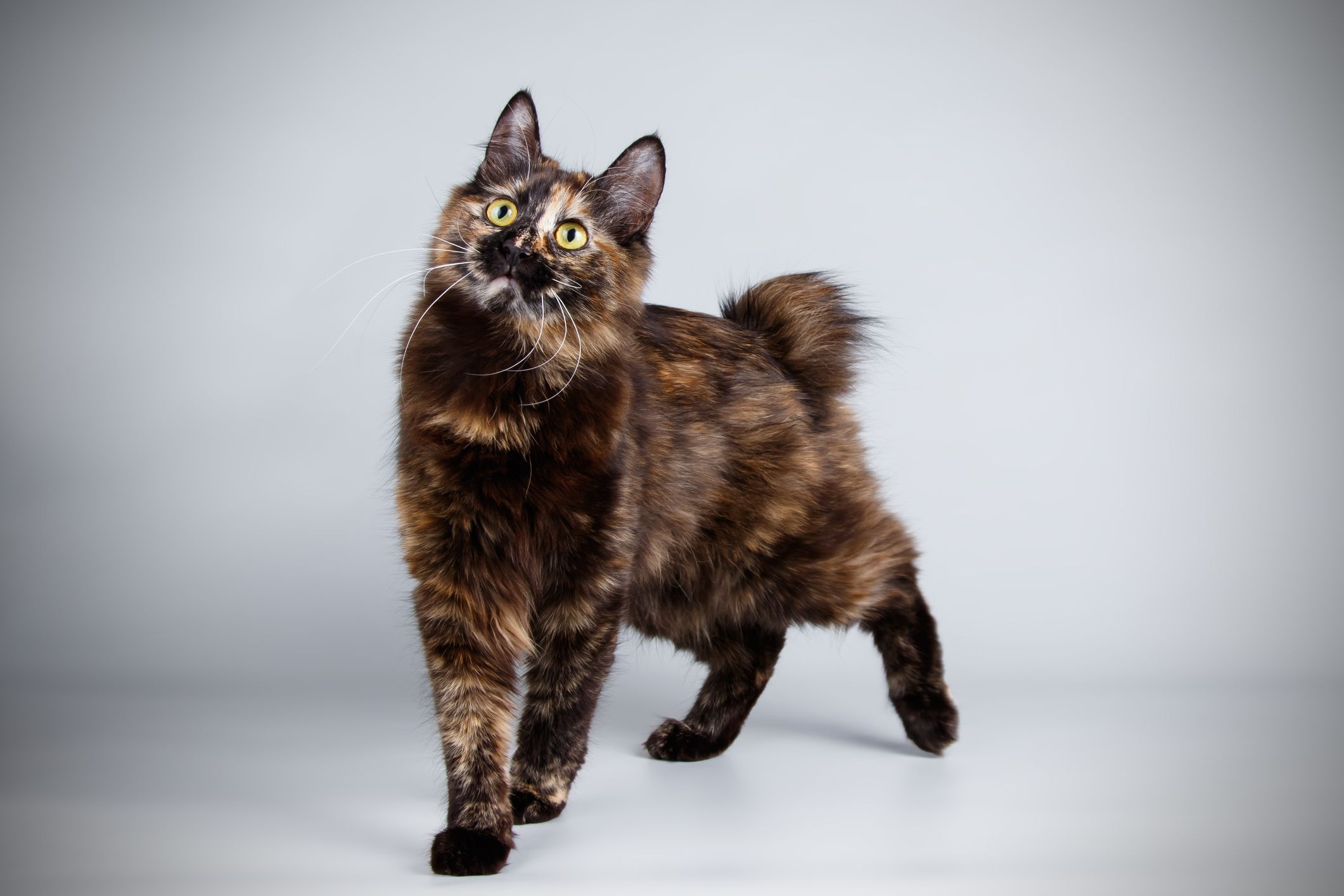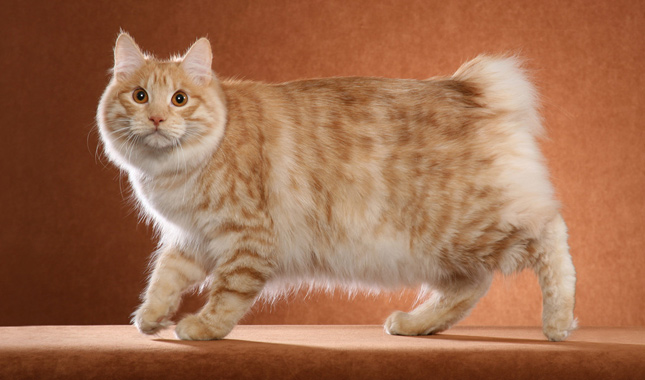A stocky cat with a lynx-like look and a distinctive short tail, the Kuril Bobtail is an impressive sight. Nevertheless, the velvet paw with the crumpled tail is a relatively unknown breed in this country. This is a charming family cat with many talents, robust health, and agility. Let yourself be inspired by the charm of the Russian island cat and learn more about the character and origin of the Kuril Bobtail here.
Kuril Bobtail: Character
The Kuril Bobtail, despite its “primitive” appearance, is an affectionate and gentle cat. She expects a lot of attention from her people. Anyone who chooses a representative of this cat breed must therefore plan a lot of time for dealing with her. In addition, at least one other cat should be present in the household to ensure species-appropriate interaction among the velvet paws. Even the best “can opener” cannot replace a conspecific.
The Russian pedigree cat is characterized by its cunning and ability to assess situations. Accordingly, in an environment that suits her, she proves to be capable of learning and can be brought up well. Her personality is open-minded, and the cat approaches strangers in a friendly manner. Nevertheless, the Kuril Bobtails usually choose a special reference person within their family to which they fixate.

Their resistance to stress is remarkable: the strong fur noses are not easily thrown off balance. If other animals are present in the household, this is usually not a problem either. With children, the velvet paw usually shows remarkable patience by cat standards.
Despite their human affinity, the Kuril Bobtail has a very high activity level and needs plenty of exercises. For example, a secure yard where she can sprint and climb trees would be ideal. The velvet paws are true four-legged “sports aces” that have to use their strength and dexterity to the full. Thanks to their strong hind legs, they are particularly talented in jumping.
It is worth noting that the Kuril Bobtail is known to be an excellent and fearless hunter, even taking on rats. If you are looking for a helper to control the rodent population in the house and yard – for example in a stable or grain store – the pedigree cat is one of the qualified candidates for this task.
Husbandry and care of the Kurile Bobtail
Life as a full-time indoor cat does not meet the needs of the Kuril Bobtail – the agile fur noses should ideally be kept in a cat-safe environment with the opportunity to roam freely.
If the cat has to stay indoors, provide plenty of stimulation and variety with hunting games as a substitute. High scratching posts and other climbing opportunities as well as free areas for stalking and sprinting should also be available at home – the Kuril Bobtail is definitely not the best choice for cramped living conditions.
Depending on the length of the fur and the cat’s living conditions, a certain level of commitment is required of you when caring for it. While weekly grooming is enough for short-haired cats, you should use a brush several times a week for medium-length hair. Kuril Bobtails with access to outdoor areas require daily tick checking and good parasite control.
The Kuril Bobtail does not have any special requirements when it comes to its food. Feed her good quality cat food in the appropriate amount.
With an average life expectancy of between 15 and 20 years, the Kuril Bobtail is one of the long-lived cat breeds, provided there are no health complications. In fact, the breed does not have any particular predisposition to hereditary diseases: adaptation to the extreme climatic conditions of their homeland has literally given cats a “thick coat” and a robust constitution. Unlike the Manx, the short tail is not associated with any skeletal impairments.
Colors of the Kurile Bobtail
The color spectrum of the Kuril Bobtail allowed according to the breed standard is quite complex: Allowed colors are red, black, blue, white, and cream with silver or gold. Colorpoint, lilac, cinnamon, fawn, or chocolate colors are not permitted.
The fur markings are liberal: everything is possible here. Kuril Bobtail cats come in tiger, tuxedo, tabby, and tortoiseshell cats.
The coat of the Kurile Bobtail is short or medium-length and silky, with hardly any undercoat. Long-haired cats stand out because of their “pants” and a mane on their neck and chest.
The History of the Kurile Bobtail
The existence of the Kurile Bobtail has been known since the 1800s. However, the breed was only introduced to a broader public in the middle of the last century, when Russian military personnel brought them to the mainland. The home of the breed is the Kuril archipelago, a chain of islands between the Kamchatka Peninsula (Russia) and the island of Hokkaido (Japan). The 1,200 km long archipelago, consisting of more than thirty islands, is politically part of Russia.
The proximity to Japan supports the theory that the Kurile Bobtail could be a “decoupling” of the Japanese Bobtail. This stubby-tailed breed of cat was bred in Japan centuries earlier. Specimens that reached the archipelago and reproduced there in the island location could be the progenitors of the “Russian” variant. On the other hand, the gene responsible for the length of the tail in the Kuril Bobtail is inherited in a different way, which in turn could be another mutation. However, the cat types also differ visually from one another.
The Kurile Bobtail has “brachyury”, a congenital shortening of the tail (although it can be flexible), accompanied by an individual “progressive form”. Something like this happens sporadically in all cat breeds. In addition to targeted breeding, special circumstances – such as an isolated island location – can lead to the genetic defect becoming established in the local population. The Kuril Bobtail is therefore a naturally created breed.

Unlike the Manx, the deviating hereditary disposition is not associated with an increased mortality rate in the kittens. When breeding, only purebred Kuril Bobtails are mated with each other.
The Kuril Bobtail is recognized as a cat breed by the FIfe (Fédération Internationale Féline) and TICA (The International Cat Association). Breeders are mainly found in the Baltic States and Ukraine, in Central Europe, the Kuril Bobtail is still considered “exotic”.
Peculiarities of the Kurile Bobtail
The most striking feature of the Kuril Bobtail is of course its pompom-like “crumpled” tail, which when “unrolled” has a length of up to 13 centimeters; but since it is kinked, angular, or even curved in a spiral, the “visible length” is only around 8 centimeters.
The fact that cats cannot use their tails like other breeds can be seen in their gait – more “hopping” than elegantly creeping. However, the Kurile Bobtail has adapted excellently to this and, thanks to its size, muscular build, and agility, is also “her cat” as a free roamer. It also owes its special stature the respectful nickname “house lynx”.